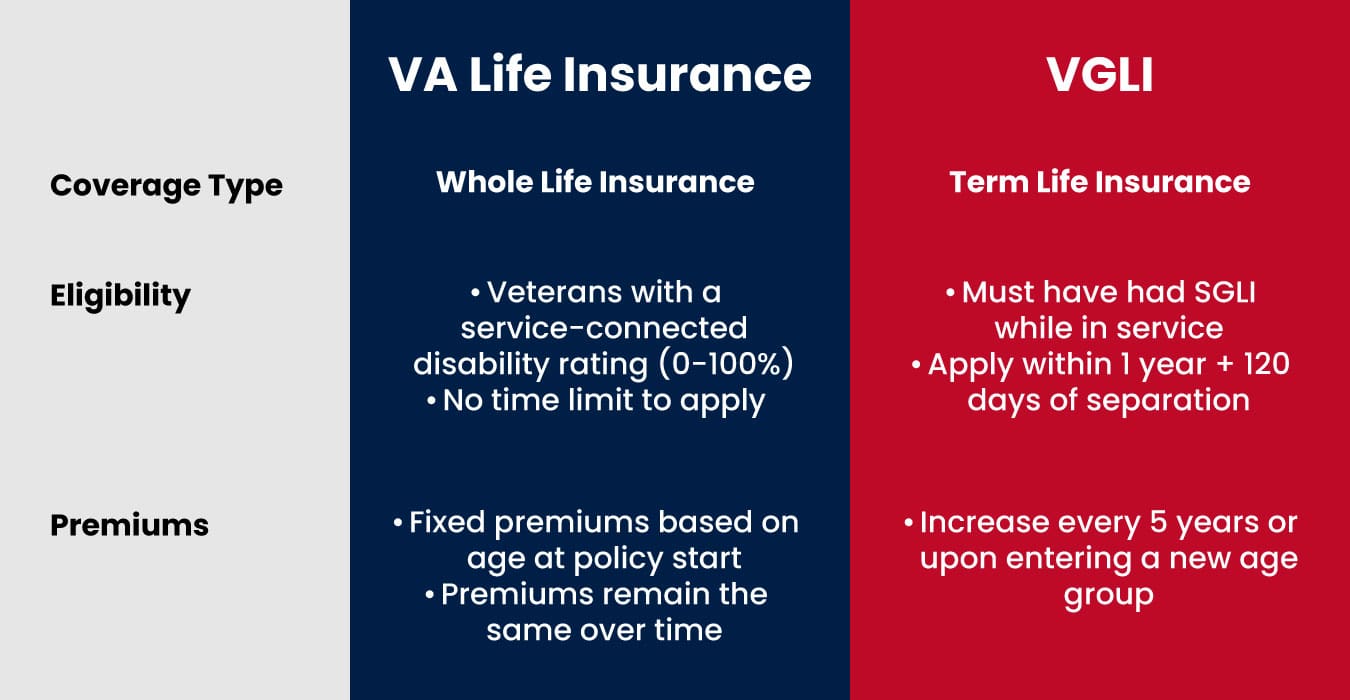Table of Contents
Navigating the world of life insurance as a Veteran can be overwhelming, especially with options like Veterans Affairs Life Insurance (VALife) and Veterans Group Life Insurance (VGLI) and the many others that all kind of sound the same. On the surface, these VA-backed programs might seem like convenient, safe choices. After all, they’re designed specifically for those who served, right? But here’s the truth: while these options might suit a small number of Veterans, they’re generally not the best financial choice for most. In this article, we’ll break down what VALife Insurance and VGLI really offer, why they might not be the best fit for your needs, and why the “buy term and invest the difference” strategy could be your ticket to a more secure financial future.
Understanding the new Veterans Affairs Life Insurance (VALife)
What is VALife?
Veterans Affairs Life Insurance (VALife) is a whole life insurance policy introduced by the VA in January 2023. It’s designed to offer coverage to Veterans with service-connected disabilities who might struggle to find insurance elsewhere. VALife provides coverage from $10,000 to $40,000, and once you’re in, your premiums stay the same for life. Sounds decent at first, but as with most things, the devil is in the details.
Why VALife Might Not Be Your Best Bet
Here’s the reality: whole life insurance, including VALife, isn’t usually the best choice for most Veterans. Or anyone who doesn’t use it as part of their estate planning really. Why? Let’s break it down:
- High Premiums: Whole life insurance, by nature, comes with hefty premiums. With VALife, you could be paying through the nose, especially as you get older. For example, a veteran in their 70s might be forking over $1,768 a month for coverage that only pays out $40,000. That’s a lot of money for not a lot of benefit.
- Limited Coverage: $40,000 might sound like a decent chunk of change, but let’s put it into perspective. That amount barely covers a modest funeral, let alone any significant financial support for your family. Contrast this with term life insurance, where you can get policies worth up to $3,000,000 for much less money. Which one sounds better to you?
- Poor Investment Returns: Whole life insurance policies often sell you on the idea of building cash value – a sort of savings account within your policy. But don’t be fooled. The returns on this “investment” are generally pathetic, especially when compared to what you could earn by investing in something like a mutual fund or an index fund that tracks the S&P 500. Plus, the insurance company skims off a hefty chunk of those returns for themselves.
- The Myth of the “Cash Value”: You might think that the cash value in your whole life policy will go to your beneficiaries when you die. Sadly, that’s not the case. Most of the time, your beneficiaries only get the death benefit, and the insurer keeps the cash value. So much for building wealth for your family.
- Lack of Flexibility: Unlike term life insurance, which you can tailor to your needs, VALife locks you into a policy for life. If your financial situation changes, too bad—you’re stuck. Term life insurance, on the other hand, allows you to adjust your coverage as your needs evolve.
Veterans Group Life Insurance (VGLI): A Closer Look
What is VGLI?
Veterans Group Life Insurance (VGLI) is a term life insurance policy that essentially acts as a whole life insurance that you can convert from your Servicemembers’ Group Life Insurance (SGLI) after separating from active duty. You can choose how much coverage you want in $10,000 increments up until the maximum of $500,000 but it depends a bit on what you had with SGLI during active duty. Sounds like a pretty good and flexible option, right? But here’s where things get tricky since VGLI is basically like taking out a new 5-year term life policy upon entering a new age group.
Why VGLI Is Bad For The Majority Of Veterans
- Acting Like a Whole Life Policy: VGLI markets itself as term life insurance, but in reality, it behaves more like whole life insurance because of its premium structure. This makes it a poor value compared to private term life insurance options, which typically offer level premiums for a set (longer) period of up to 30 years.
- Premiums That Rise With Age: One of the biggest problems of VGLI is that your premiums don’t stay the same. VGLI seems affordable when you’re fresh out of the service, but fast forward 20 or 30 years, and you could be paying a small fortune every month just to keep your coverage and most Veterans choose to give up their VGLI with age since they simply cannot afford the payments anymore. Imagine paying $2,250 a month at age 80 for $500,000 in coverage.
- Coverage Limitations: While VGLI offers more coverage than VALife, $500,000 might still not be enough for Veterans with significant financial obligations, like a mortgage or college tuition for kids. Whereas private term life insurance policies can provide much higher coverage amounts at a fraction of the cost.
VALife vs. VGLI: Don’t Confuse the Two
It’s easy to see why so many Veterans mix up VALife and VGLI—they’re both VA-backed, they both offer life insurance, and their names are pretty similar, and one policy tries to imitate the other. However, they couldn’t be more different.

- Type of Insurance: VALife is whole life insurance, meaning it’s designed to cover you for your entire life. VGLI is basically a 5-year term life insurance policy, offering coverage for only this specific time frame. Upon entering a new age group, you enter into a new policy. Hence the change in premium every 5 years.
- Eligibility: VALife is targeted specifically at Veterans with service-connected disabilities, with no time limit to apply. VGLI, on the other hand, is available to any Veteran who had SGLI while in service, but you need to convert your policy within one year and 120 days after separation.
- Premium Structure & Death Benefit: With VALife, your maximum coverage is $40,000 and your premiums are fixed based on your age when you apply, but they start high. VGLI’s maximum is $500,000 and your premiums start lower but increase sharply as you age.
Understanding these differences is crucial if you’re trying to figure out which policy, if any, is right for you.
The “Buy Term and Invest the Difference” Strategy: A Smarter Alternative
Now you know the difference between VGLI and VA Life Insurance (VALife), let’s take a look at what the majority of Veterans actually should do to protect their family and leave them a sizeable inheritance: “buy term and invest the difference.”. You essentially insure your “working years” with term life insurance while you build up your own investments through something like a Roth IRA or mutual fund tracking a broad index like the S&P 500. You can read up on why buying whole life insurance is not even in the consideration and a bad choice here.
Why It’s Better
- Significantly Lower Premiums: Term life insurance is much cheaper than whole life insurance. For example, a 30-year-old Veteran could pay as little as $27 per month for a $500,000 term life insurance policy. Compare that to the average $451 per month you might pay for whole life insurance, and the difference is staggering. And let’s not even talk about VALife – that same $30 a month might only get you $20,000 in coverage.
- Much Higher Returns: By investing the money you save on lower premiums into something like an index fund, you could see returns averaging around 10% per year. Historically, the S&P 500 has delivered these kinds of returns, far outstripping anything a whole life policy could ever offer. And with modern technology it’s as easy to set up as paying for your morning coffee with your card.
- No Hidden Fees: Term life insurance is straightforward. You know what you’re paying for, and there are no hidden fees or gimmicks. What you see is what you get, which isn’t something you can always say for whole life policies or VGLI.
- Flexibility and Control: Term life insurance allows you to adjust your coverage as your needs change. Plus, when you invest the difference, you’re in control of your money. Need to tap into your investments? Want to use it as collateral for a loan? Want to change your investment strategy? No problem. You’re the boss.
What About Disabled Veterans? Do You Have Any Options?
If you’re a disabled Veteran, you might be wondering if you can even get life insurance outside of VALife. The good news is that you probably can. Despite the myths floating around, most life insurance companies will insure disabled Veterans. In fact, even Veterans with PTSD can often get term life insurance, and yes, those policies generally pay out even in cases of suicide after a waiting period.
If you’re totally disabled (100%), you might have been eligible for a free life insurance for 100% disabled Veterans policy (S-DVI) before it was discontinued at the end of 2022. But unfortunately, VALife replaced this policy, and it doesn’t offer free insurance. It does however provide guaranteed acceptance for those with service-connected disabilities in case you really don’t qualify for any other insurance.
For most Veterans, though, term life insurance combined with smart investing is still the way to go, even if you’re dealing with a disability. The key is to shop around, get multiple quotes, and find a policy that works for you.
Conclusion: Making the Best Financial Choice for Your Future
We know life insurance can be a daunting and confusing topic but it’s fairly simple if you know what you’re looking for. And while VA backed programs like VA Life Insurance or VGLI seem appealing, they’re often not the best choice for the majority of Veterans – even if they’re disabled as they come with high premiums, little coverage, and poor (no) returns. These policies could have been good and a real help to Veterans, but unfortunately, at the moment, they’re not.
Instead, you might want to consider the “buy term and invest the difference” strategy. It does not only offer lower cost, better returns and a greater flexibility but it’ll also make you become “self-insured” – meaning at a certain age your investments will far outweigh any potential life insurance death benefit.
Whether you’re about to separate from active duty or a Veteran looking to reevaluate your insurance needs – this approach is the key to protecting your family and building long term wealth. Remember, life insurance is only one part of your financial plan. It’s insurance. Nothing else. Like it would be with your home insurance. You’re building your financial home yourself – the insurance is simply protecting it.

